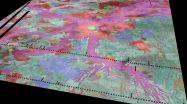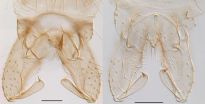(Press-News.org) (WASHINGTON, June 18, 2015) - New research published online today in Blood, the Journal of the American Society of Hematology (ASH), concludes that a blood clot in an abdominal vein may be an indicator of undiagnosed cancer. The study also suggests that these clots predict poorer survival in patients with liver and pancreatic cancer.
Compared to the general population, individuals who develop blood clots in their legs (deep-vein thrombosis, or DVT) or lungs (pulmonary embolism, or PE) are two to four times more likely to be diagnosed with cancer within the next year. In the presence of cancer, the blood can clot more easily. An expanding tumor may compress a vein in its path, reducing or minimizing blood flow. In other cases, surgery, inflammation, or tumor growth can injure blood vessels, promoting clotting.
While much is known about the association between DVT, PE, and subsequent cancer diagnoses, less is known about how clots in the veins that carry blood through the liver and other abdominal organs could serve as a marker for cancer. These clots, called splanchnic venous thrombosis (SVT), are rare and typically only form as the result of another complication.
To better understand whether SVT could indicate an undiagnosed cancer, researchers analyzed the medical discharge diagnoses of more than 1,000 Danish patients diagnosed with the abdominal clots from 1994-2011. Researchers followed the 1,191 patient records for a median of 1.6 years, calculating their risk of having a subsequent cancer diagnosis compared to the expected risk in the general population in Denmark. Researchers also assessed the survival outlook of patients with SVT as compared to cancer patients without blood clots.
"As we learn more about the association between many types of thromboses and cancer, we also want to better understand these more rare clots and how they can perhaps signal a hidden cancer," said lead study author Kirstine K. Søgaard, MD, of Aarhus University Hospital in Aarhus, Denmark. "In this case, we had access to comprehensive data that we believed could provide insights useful to clinicians caring for patients with this condition."
After linking the SVT patient records to the Danish Cancer Registry, the investigators observed that 183 of the 1,191 patients were later diagnosed with cancer, and more than half (n=95) of these cancers were identified within three months of SVT diagnosis. The majority of these cancers occurred in the liver, pancreas, or blood. After comparing cancer incidence among SVT patients with national Danish cancer rates, investigators estimated that patients with SVT were 33 times more likely to be diagnosed with cancer than expected during the first three months following SVT diagnosis.
Seeking to understand how SVT might affect survival in those patients with cancer, the research team compared survival in these patients with a matched cohort of cancer patients without the blood clots. While patients with liver or pancreatic cancer had a poor outcome regardless of SVT, patients with SVT and these cancers had markedly worse three-month survival outcomes than cancer patients without the clots (44% v. 55% for patients with liver cancer, and 33% v. 53% for patients with pancreatic cancer). While researchers did not observe a significant difference in survival between blood cancer patients with and without SVT, they noted a higher incidence of myeloproliferative neoplasms beyond 12 months following SVT diagnosis, potentially indicating delayed diagnosis.
"This study is the first to demonstrate in a large population that patients who develop splanchnic venous thrombosis are likely to be diagnosed with cancer within a relatively short time period," said Dr. Søgaard. "As we continue to learn more about patients who suffer from these blood clots, it will be important to examine the pros and cons of screening for these hidden cancers."
INFORMATION:
Blood, the most cited peer-reviewed publication in the field of hematology, is available weekly in print and online. Blood is the official journal of the American Society of Hematology (ASH), the world's largest professional society concerned with the causes and treatment of blood disorders.
ASH's mission is to further the understanding, diagnosis, treatment, and prevention of disorders affecting blood, bone marrow, and the immunologic, hemostatic, and vascular systems by promoting research, clinical care, education, training, and advocacy in hematology.
blood® is a registered trademark of the American Society of Hematology.
Global warming leads to the ice sheets on land melting and flowing into the sea, which consequently rises. New calculations by researchers from the Niels Bohr Institute show that the sea level in Northern Europe may rise more than previously thought. There is a significant risk that the seas around Scandinavia, England, the Netherlands and northern Germany will rise by up to about 1½ meters in this century. The results are published in a special issue of the scientific journal Climate Research.
Sea level rise is a significant threat to the world's coastal areas, ...
Astronomers making a detailed, multi-telescope study of a nearby galaxy have discovered a magnetic field coiled around the galaxy's main spiral arm. The discovery, they said, helps explain how galactic spiral arms are formed. The same study also shows how gas can be funneled inward toward the galaxy's center, which possibly hosts a black hole.
'This study helps resolve some major questions about how galaxies form and evolve,' said Rainer Beck, of the Max-Planck Institute for Radio Astronomy (MPIfR), in Bonn, Germany.
The scientists studied a galaxy called IC 342, some ...
Patients seeking certainty in genetic tests often receive a perplexing result. Many learn they carry a 'variant of unknown significance' of a disease-linked gene. Such variants might -- or equally might not -- increase disease risk.
A study published in the June issue of the journal Genetics characterized nearly 2000 variants of the breast cancer-associated gene BRCA1, demonstrating the potential of a new approach for sorting out which variants are harmful and which are harmless.
Because genetic tests increasingly use more comprehensive multi-gene and whole-genome sequencing ...
ALLENDALE, Mich. -- A Grand Valley State University biology professor and her team of scientists have determined new information about an endangered species in the U.S., which could impact its protection under the Endangered Species Act.
The study, "Two Tickets to Paradise: Multiple Dispersal Events in the Founding of Hoary Bat Populations in Hawai'i," was recently published in PLOS ONE at http://journals.plos.org/plosone/article?id=10.1371/journal.pone.0127912.
The study, led by Amy Russell, associate professor of biology at Grand Valley, reveals that the Hawaiian ...
(Philadelphia, PA) - A little more than a decade ago, researchers discovered that all cells secrete tiny communications modules jammed with an entire work crew of messages for other cells. Today, a team of researchers, led by stem cell researcher Raj Kishore, PhD, Director of the Stem Cell Therapy Program at the Center for Translational Medicine at Temple University School of Medicine (TUSM), is harnessing the communications vesicles excreted by stem cells and using them to induce the damaged heart to repair itself. Their research is the June 19 cover story in the leading ...
PROVIDENCE, R.I. [Brown University] -- An international team of scientists has found some of the best evidence yet that Venus, Earth's nearest neighbor, is volcanically active.
In combing through data from the European Space Agency's Venus Express mission, the scientists found transient spikes in temperature at several spots on the planet's surface. The hotspots, which were found to flash and fade over the course of just a few days, appear to be generated by active flows of lava on the surface.
"We were able to show strong evidence that Venus is volcanically, and thus ...
Currently, there are more than 350 million type 2 diabetics and according to the World Health Organization (WHO) by 2030 it will be the 7th leading cause of death worldwide.
The hallmark of type 2 diabetes is insulin resistance, which is initially compensated for by an increase in beta cell size (responsible for producing insulin). However, the beta cells of such patients will eventually collapse and die, leading to full blown type 2 diabetes.
Researchers from the Laboratory of Cancer Metabolism at IDIBELL, led by Sara Kozma, have shown in animal models that inhibition ...
NEW YORK (June 18, 2015) - Proper laundering and handling are important in achieving and maintaining the hygienically-clean quality of healthcare fabrics and textiles delivered to the point of care, according to a new review that highlights evidence-based strategies to inhibit potentially serious contamination. The review, based on findings and recommendations from peer-reviewed studies, as well as current standards and guidelines, is published online in Infection Control & Hospital Epidemiology, the journal of the Society for Healthcare Epidemiology of America (SHEA). ...
Over 35 million people worldwide are currently infected by HIV. Antiviral therapies can keep the virus from multiplying. However, no drug can cure infection so far, because various cell types continue to carry the virus in a latent, i.e. quiescent, state. Scientists of Helmholtz Zentrum Muenchen have now established a model for latent HIV infection of brain cells. The researchers used this model to identify various compounds that affect latency of the virus in the brain. This study was published in the journal AIDS.
"Chronic infection is caused by long-lived cells with ...
Revisiting original types and DNA analysis exposed hidden diversity in minute non-biting midges. Two species new to science were discovered and one misapprehended species was removed by following the traces back to the source in Brussels. The study was published in the open access journal ZooKeys.
"Nobody suspected a mystery until we solved it", says Elisabeth Stur, the senior author of the paper describing the misconception. - "Maybe even some will be upset that we discovered this long lasting misidentification".
It all started with Elisabeth Stur and Torbjørn ...


